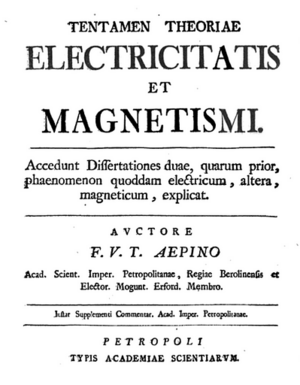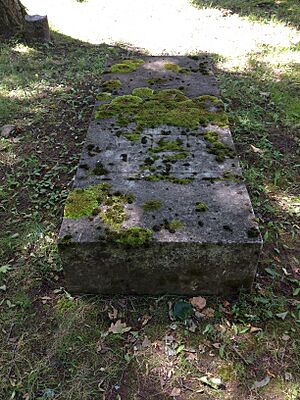Franz Aepinus facts for kids
Quick facts for kids
Franz Aepinus
|
|
|---|---|
| Born | 13 December 1724 Rostock, Duchy of Mecklenburg-Schwerin, Holy Roman Empire
|
| Died | 10 August 1802 (aged 77) Dorpat, Livonia, Russian Empire
|
| Nationality | German, Russian |
| Scientific career | |
| Fields | electricity and magnetism, astronomy |
Franz Ulrich Theodor Aepinus (born December 13, 1724 – died August 10, 1802) was a very smart German scientist. He was a mathematician and a natural philosopher. He lived and worked in the Russian Empire. Aepinus is most famous for his deep studies and experiments in electricity and magnetism.
Contents
Who Was Franz Aepinus?
Franz Aepinus was born in Rostock, a city in what was then the Duchy of Mecklenburg-Schwerin. This area is now part of Germany. His family had a long history. He was related to Johannes Aepinus, who lived from 1499 to 1553. Johannes was an important religious leader during the Protestant Reformation. He was the first in the family to use the Greek form of their last name, Hugk or Huck.
His Amazing Career
Franz Aepinus first started studying medicine. But he soon decided to focus on physics and mathematics. He became so good at these subjects that he was invited to join the Prussian Academy of Sciences. This was a very important group of scientists.
In 1755, he briefly led the Astronomisches Rechen-Institut. This institute helps calculate positions of stars and planets. In 1757, Aepinus moved to St Petersburg in Russia. There, he became a member of the Russian Academy of Sciences. He also worked as a professor of physics. He stayed in Russia until he retired in 1798.
He spent the rest of his life in Tartu, which was then called Dorpat. He was well-liked by Empress Catherine II of Russia. She even asked him to teach her son, Paul. Aepinus also tried to set up special schools across the Russian Empire. In 1760, he was chosen as a foreign member of the Royal Swedish Academy of Sciences.
Aepinus's Important Works
Aepinus wrote a very important book called Tentamen Theoriae Electricitatis et Magnetismi. This means "An Attempt at a Theory of Electricity and Magnetism." It was published in St. Petersburg in 1759. This book was the first time someone tried to use mathematical rules to understand electricity and magnetism.
He also wrote another book in 1761. It was called De Distributione Caloris per Tellurem, which means "On the Distribution of Heat in the Earth." Besides these books, he wrote many articles. These articles were about different topics like astronomy, mechanics, optics, and pure mathematics. They were published in the science journals of St. Petersburg and Berlin.
One of his articles was about how parallax affects how we see a planet crossing the sun. Parallax is how an object seems to shift when you look at it from different angles. This article was very interesting because it came out in 1764. This was between two times when the planet Venus crossed the sun in the 1700s.
His Ideas About Electricity
Aepinus was the first to explain how electricity works over a distance. He showed that this idea could explain experiments about electrostatic induction. This is when an object becomes electrically charged just by being near another charged object. His ideas helped create the field of electrostatics, which is the study of electric charges that are not moving.
His theory was similar to Isaac Newton's ideas about gravity. Both theories suggested that forces could act over a distance without touching. However, Aepinus also thought that forces needed contact to be passed on. These ideas might seem a bit confusing today. But they show how scientists create "models" to understand the world around them. These models are like simplified maps of how things work.
Another scientist named Henry Cavendish also came up with similar ideas about electricity. He developed his theories without knowing about Aepinus's work. Aepinus published his theory about ten years before Cavendish. Their ideas helped to end the belief that electricity was made of two different "fluids." Instead, they showed it could be explained by forces.
See also
- List of German scientists



